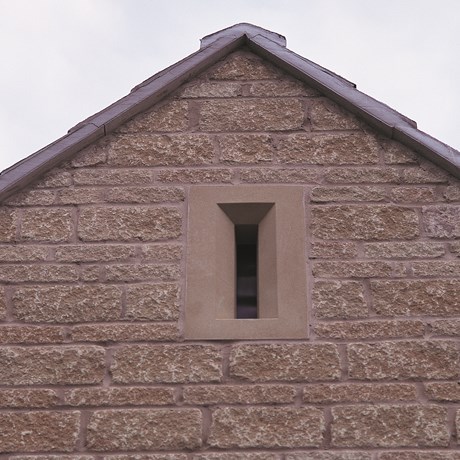Gable
A gable is a section of wall located at the end of a pitched roof, between the edges of the intersecting pitches. It is usually triangular and extends from the eaves to the ridge, although the shape and detailing depends on the particular structural system used for the roof. The term ‘gable wall’ (or ‘gable end’) is used to refer to the gable and the whole wall below it.
In classical architecture, a gable was referred to as a pediment.
As well as being designed to be aesthetically pleasing, a gable should be capable of preventing water from entering the intersection between wall and roof. This can be done by carrying the roof out over the top of the end walls, or by raising the end walls above roof level to form a parapet capped with a waterproof coping.
The latter design can take several different forms in terms of its outline. Where roofs are of a steep pitch, gables are sometimes decorated with stepped or curved forms, ornamented with grotesques, statues, scrolls, and so on. A common example is a crow-stepped gable, also known as a stepped gable or corbie step, which takes the form of a stair-step pattern at the top of the stone or brick parapet wall which projects above the roofline. They can be designed with integral windows or vents (as in the above image).
Gables tend to be an inappropriate design for buildings located in hurricane regions since the wind pressures exerted on the gable end can cause the roof to fail.
Rather than constructing gables from masonry, they can be formed by prefabricated spandrel panels. These panels can be installed quickly by crane, and mean that roofing contractors can complete the wall elements under the roof rather than having to get brick or block layers to return to site.
[edit] Related articles on Designing Buildings
Featured articles and news
Government consultations for the summer of 2025
A year of Labour, past and present consultations on the environment, the built environment, training and tax.
CMA competitiveness probe of major housing developers
100 million affordable housing contributions committed with further consultation published.
Homes England supports Greencore Homes
42 new build affordable sustainable homes in Oxfordshire.
Zero carbon social housing: unlocking brownfield potential
Seven ZEDpod strategies for brownfield housing success.
CIOB report; a blueprint for SDGs and the built environment
Pairing the Sustainable Development Goals with projects.
Types, tests, standards and fires relating to external cladding
Brief descriptions with an extensive list of fires for review.
Latest Build UK Building Safety Regime explainer published
Key elements in one short, now updated document.
UKGBC launch the UK Climate Resilience Roadmap
First guidance of its kind on direct climate impacts for the built environment and how it can adapt.
CLC Health, Safety and Wellbeing Strategy 2025
Launched by the Minister for Industry to look at fatalities on site, improving mental health and other issues.
One of the most impressive Victorian architects. Book review.
Common Assessment Standard now with building safety
New CAS update now includes mandatory building safety questions.
RTPI leader to become new CIOB Chief Executive Officer
Dr Victoria Hills MRTPI, FICE to take over after Caroline Gumble’s departure.
Social and affordable housing, a long term plan for delivery
The “Delivering a Decade of Renewal for Social and Affordable Housing” strategy sets out future path.
A change to adoptive architecture
Effects of global weather warming on architectural detailing, material choice and human interaction.
The proposed publicly owned and backed subsidiary of Homes England, to facilitate new homes.
How big is the problem and what can we do to mitigate the effects?
Overheating guidance and tools for building designers
A number of cool guides to help with the heat.
The UK's Modern Industrial Strategy: A 10 year plan
Previous consultation criticism, current key elements and general support with some persisting reservations.
Building Safety Regulator reforms
New roles, new staff and a new fast track service pave the way for a single construction regulator.

























